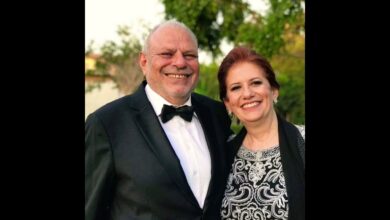Few artworks in the contemporary Egyptian art scene leave viewers, regardless of their backgrounds and tastes, in awe. The diverse body of works by Egyptian artist Amal Kenawy, however, almost always did. The multi award-winning Kenawy sadly passed away on Sunday at the age of 38. She had leukemia.
Kenawy worked across a range of media, from drawing and painting to sculpture, video and performance. Her diverse approaches to artistic practice stemmed from her interdisciplinary training at the historical dress, animation and decor section at the Cinema Institute, and later at the painting department of the Faculty of Fine Arts, in addition to her continuous drive to experiment. She was an artist and a craftswoman in the true sense of the word.
Beginning in 2002, Kenawy began performing and exhibiting beyond the mainstream galleries of the time. The video and performance piece “The Room,” in which Kenawy sewed beads onto a beating heart, was shown in a cultural festival in Minya as well as at the Townhouse in downtown Cairo. And as Kenawy explained in a previous interview with Egypt Independent, the public’s reception of the work in Minya was stronger. Audience members were intrigued and came up to her asking her about the work. That was Kenawy’s first solo exhibition after working for over a decade with her elder brother and mentor Abdel Ghany.
Kenawy’s 2005 “The Purple Artificial Forest,” first exhibited at the Falaki gallery of the American University in Cairo, amazed viewers with its emotional intensity, but also for how the artist showcased her whole development process from the initial sketches and notes to the sculptures of the purple creatures appearing in the animated video. One walked through the installation and was caught between the intense soundtrack, composed by Kenawy, and the visuals. Even those who are not big fans of the artist’s ideas cannot help but acknowledge the intensity of her work and the effect it has on viewers.
Kenawy often sought to challenge viewers and society at large, as well as the confines of the local art scene and the exclusivity of galleries in Cairo. For the 12th International Cairo Biennale in which she received the grand prize, Kenawy exhibited a much contested work, “Silence of the Sheep.” In December 2009, she had orchestrated a short performance in downtown’s Champollion Street, where she led a group of artists and laborers crawling on their hands and feet across the street, while Kenawy walked before them like a shepherd. Expectedly, pedestrians and residents were infuriated by the scene and started a fight, claiming that the artist was humiliating the poor workers. But the work took on a new meeting with Kenawy showing documentation of the performance as a looped video at the Palace of the Arts, along with two videos of Kenawy’s son and a man desperately trying to escape a wheel chair, all exhibited in a warm home setting complete with Christmas lights and home cooked food, which she personally served to visitors on the opening night.
Kenawy went on to garner numerous awards at local and international exhibitions throughout her career. But a key characteristic of her work has been renewal, setting her apart from many. She consciously moved away from her early stop-motion animation videos into other modes of art making. In the 2007 Sharjah Biennale, the artist exhibited her award-winning “Non-Stop Conversation.” She carefully sewed bubblegum pink quilt fabric around an abandoned building on the skirts of the heritage area, while shuddering mechanical music played in the background. And in early 2011, Kenawy exhibited “My Lord is Eating his Tail” at the 17th Biennale of Sydney. The video piece examined states of social stagnation brought about by miscommunication through a performance in which a narrative was translated into pure physical expression.
Kenawy’s artistic legacy is endless and her approach inspiring to many. She will be missed.




